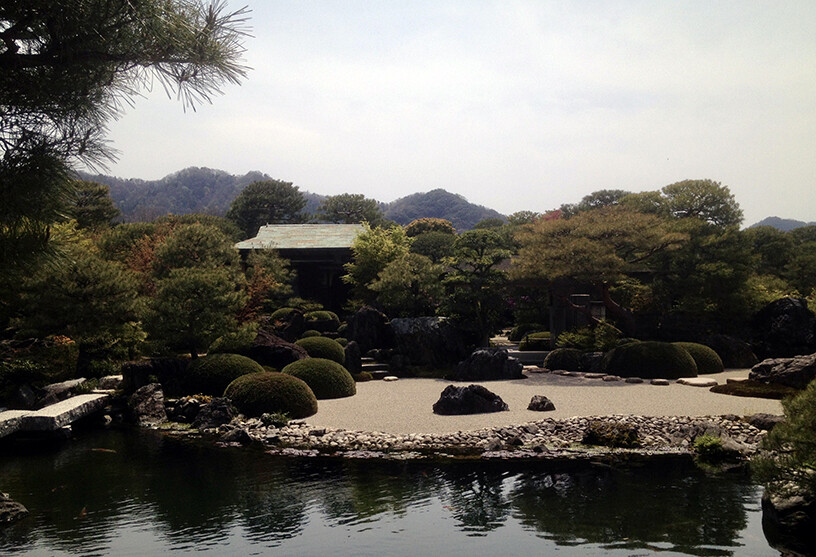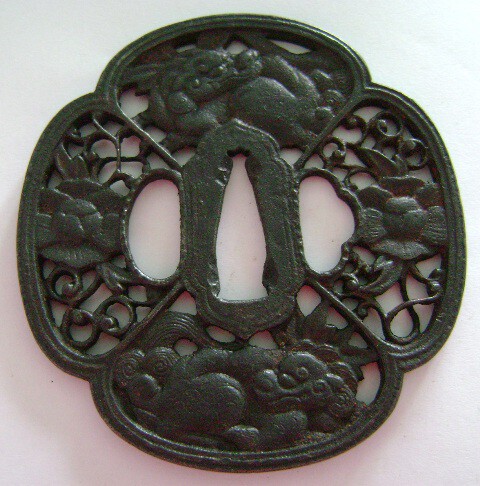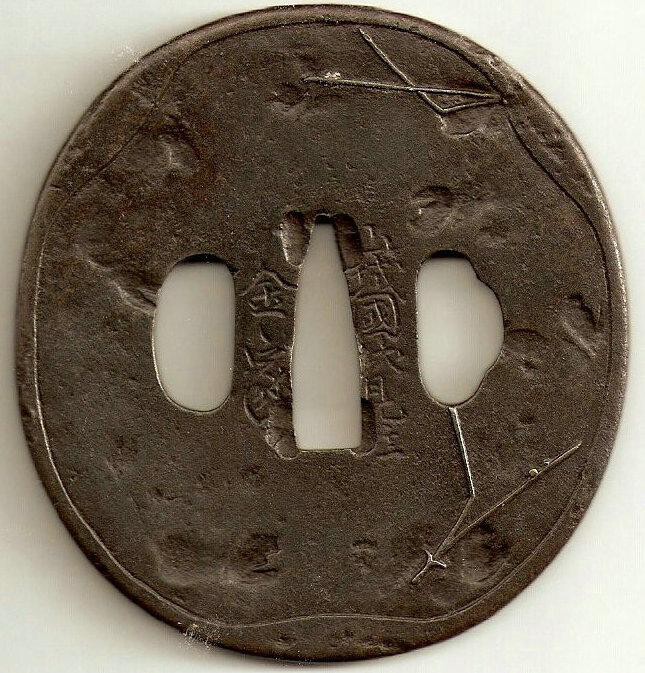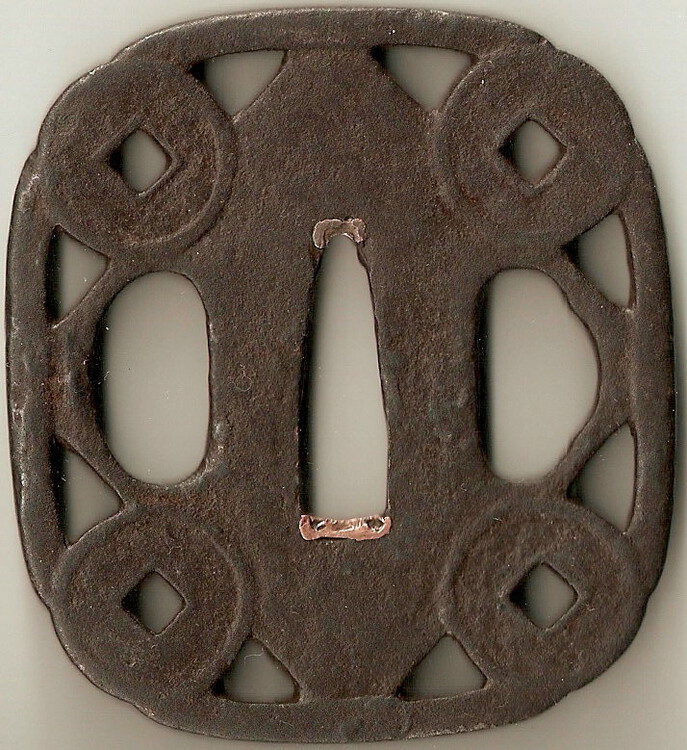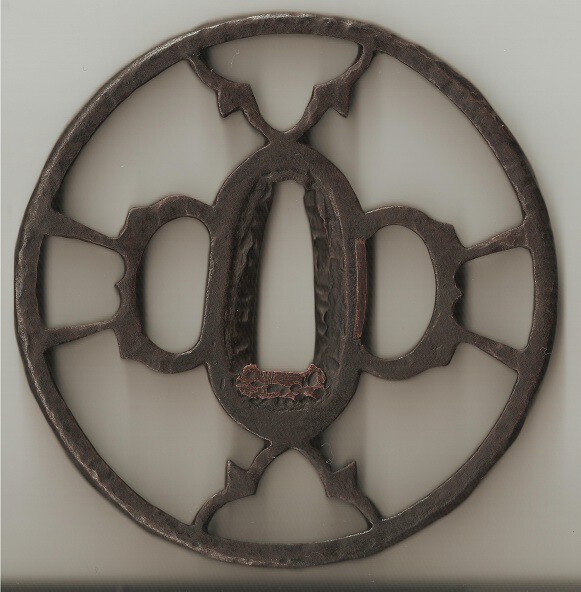-
Posts
2,886 -
Joined
-
Last visited
-
Days Won
3
Everything posted by Soshin
-
Thanks John for the information. I should pick this book up some time soon as I have a deep interest in learning more about Nanban tsuba and collecting them. The three issues of the NBTHK Token Bijutsu magazine I have about Nanban tsuba hasn't been translated by Markus S. of the NBTHK-EB yet. Yours truly, David S.
-
Its a really nice kinko Nanban and would make a nice addition to the collection of anyone who likes Nanban tsuba. On a related note here is some good photos with flash I did of my tsuba that I started the the thread with. The third photo shows the thickness of the rim and the 3D nature of the low relief carving that is wonderful executed. Also some fine granular tekkotsu can also be observed along the rim but I don't have the camera to capture it. I don't think the tekkotsu were intentional by the artisan and is likely due to just natural variations in the forged iron. I came across this recent book on Amazon about Nanban tsuba: http://www.amazon.com/Namban-Group-Japanese-Sword-Guards/dp/1554043654/ref=wl_it_dp_o?ie=UTF8&coliid=I3EVL67AM8RHJ1&colid=ANXGUP86KQV6. Has anyone ever read it? Thanks again everyone for the discussion. Yours truly, David S.
-
Hi Grey, I think some of the later poorer Nanban tsuba were made of cast iron circa the Meiji Period. Here is an example I once owned and I later sold as a Meiji Period Nanban style cast iron tsuba. It had a similar casting seam along the mimi as in photo number three of the tsuba listed on eBay. My tsuba was mounted on a wakazashi as I had a matching seppa and habaki along with the tsuba. The wakazashi that it was mounted on likely had rusted apart as it had come out of Japan. I even include the collectors tag he was thinking it was late Edo Period but I dated it even younger. Yours truly, David S.
-
Could you post photos of both side of the tsuba? Having the measurements of the tsuba would also be helpful for identification. Thanks. Yours truly, David S.
-
The color and contrast of the scan looks kind of strange. A photo might be much better. The red color does remind me of soapstone but the tsuba is likely made of a soft metal such as copper or brass with a reddish patina applied to it. The carving on the tsuba is remarkable and I like it. Yours truly, David S.
-
Thanks everyone for sharing some examples. Nanban tsuba are one of those type of tsuba that has a complete range in quality from very great to poor made all during the Edo Period. Here are some fine examples likely paper at Tokubetsu Hozon level and above provided by the NBTHK. Sadly I don't own any of these. But they do provide a reference point for what good Nanban tsuba look like. Yours truly, David S.
-
Hi Mariuszk, I would agree the low relief craving does remind me of the Ito school of Bushu (i.e. Bushu/Ito). Although the scroll work between flowers and shi shi, seppa-dai shape, and kaku-mimi rim are clearly of Nanban design. Another interesting aspect of the tsuba is that the mimi show some fine granular tekkotsu. I think this was likely unintended and caused by natural inconsistencies in the relative soft iron used to make the tsuba. I hope to take some photos of the rim under good light this coming Saturday. Yours truly, David S.
-
I was thinking the star consolation was more of a Japanese then Chinese theme as I have seen it in non Nanban tsuba before but it is likely part of the common folklore system that the two cultures share. Much like the Chinese Lion dogs (don't know the Chinese) called Shi shi in Japan which are featured on my Nanban tsuba. Thanks again everyone for taking the share and discuss their favorite. I came across some really nice examples in the NBTHK monthly magazine (Issues# 646-648). When I get a chance this evening I will post some scans for discussion. Yours truly, David S.
-
I would agree with Bob. The Akasaka tsuba looks nice to me and the price is reasonable. The motifs really go good together nicely. Yours truly, David S.
-
Just wanted to start this thread about sharing your favorite Nanban tsuba for discussion. If you don't like Nanban tsuba then please just ignorer the tread. To start the thread I will offer a Nanban tsuba I recently purchased. My new Nanban tsuba has a clear Chinese influence but lack the typical dragons chasing a diamond style motifs. In my tsuba the dragons are replaced by lazy Chinese lion dogs and diamonds are replaced by peonies. Here is a writer-up up I am doing about the tsuba. This is a large tsuba at 8.5 X 8.0 cm. These are photos provided by the dealer who might be on the forum. I haven't had a chance to photograph the tsuba as the difference in height of the craved surface makes it hard to scan. Information, comments, and discussion about my favorite or your favorite Nanban tsuba are welcome. :D Yours truly, David S.
-
Hi Robert M., Here is a write up I did about the Shippo design as I have it on a sukashi tsuba in my collection. I hope you find the information helpful. Yours truly, David S.
-
The tsuba looks to be fairly typical of sukashi done it the late Edo Period. The price is reasonable for a starter tsuba for someones collection, in good condition, but just nothing special. The points are critical about the price and condition as we are talking about eBay. Just to clear something up I often don't reply to posts in this forum because I don't have any useful information to provide not because a specific piece is low quality. Often young collectors need feedback about things they are considering to purchase or have already added to their collection. I tend to use the NBTHK Token Bijutsu monthly magazines as my information source of very high quality tosogu. Yours truly, David S.
-
I think you are correct in regards to the ko-sukashi design of a star constellation of seven stars forming a celestial dragon. The design is not complete enough to be shippo. Yours truly, David S.
-
From the looks of the tsuba in the photos. It looks like the tsuba has been cleaned and repatinated. I cannot confirm this without having the tsuba in hand and examining it closely under good lighting conditions. The complete lack of rust any and the color is good evidence of the repatination. I have a old tsuba like this from the Momoyama Period that was repatinated at some point awhile ago possibly in the Late Edo period after it was hit with a musket ball on the ura side and a iron sekigane added to kozuka hitsu-ana. It has much less rust then would be expected of such a old tsuba and the color is typical for Edo Period tsuba. It was likely completely cleaned and altered before it was repatinated. Overall I still like my tsuba as the iron is still really nice. I can confirm that there was a Bizen Shoami school active during the Edo Period. Yours truly, David S.
-
Hi Fred D., I would say that the tsuba is likely Choshu and would date it to the middle Edo period (ca. 1670 – 1770). I am sure a more complete judgement can be obtained from a formal shinsa via the NTHK or NBTHK. Overall I like the design and craftsmanship of the tsuba. Yours truly, David S.
-
Hi Mariuszk, I am going to abstain from this discussion for the most part after getting in trouble on another forum. Only thing I can say that this tsuba like the Myochin school tsuba I would love to own regardless of the fact that they are cast iron. Comparing these late Edo Period cast iron tsuba to Meiji Period tourist items is a bit like comparing Fuji Apples and Crab Apples. :D Yours truly, David S.
-
Here are three of my favorite tsbua I own as part of my tosogu collection. Included are some breif write up about each tsuba. Yours truly, David S.
-
Hi Hatanaka-san, Welcome to the Nihonto Message Board and I will bookmark your website and take a look at what you have to sell. This is fairly good place for information. I recommended checking out the forum search feature as well as the collection of links to other related website about nihonto and tosogu. Yours truly, David S.
-
Thanks for posting a wonderful Umetada tsuba. :D Gold inlay work along the mimi with a ji of shakudo is very nice. I have a few examples of the school's work in iron with soft metal inlays of brass (shinchu-zogan). What are the measurements including thickness for your tsuba that you posted for discussion? Yours truly, David S.
-
Thanks Carl for taking the time to photograph the other parts of the tanto koshirae. Overall I like the koshirae and I think it matches well and dates to the late Edo Period. The tanto itself likely dates earlier then the late Edo Period as the nakago looks like it has been shorted at some point. The multiple mekugi-ana is strong evidence as well as the lack of a mei. The original signature might have been lost when it was shorten. The Japanese term for this shorting of the nakago (i.e. tang) as well as the overall sword is suriage. Yours truly, David S.
-
This looks to be a real tsuba (i.e. not a Chinese reproduction). The design of the tsuba indicates that the tsuba likely dates to the late Edo Period. The condition is really poor likely due to neglect. Due to the presence of inlays you must be very mindful and careful with the rust removal process and not damage the soft metal inlays. Just my two cents. Thanks for sharing the tsuba for discussion. Yours truly, David S.
-
I would say the original age of tsuba to be middle to late Edo Period. The sukashi might be a recent modification (i.e Showa Period). As to what school I am not really sure. Hopeful someone more experienced would offer some advice. Yours truly, David S.
-
I would agree the sukashi doesn't look original. The tsuba openwork also don't show any of the normal signs of age. The sukashi looks similar to another tsuba I have which has added openwork. Below is the tsuba in question. I had a few fellow members of my local Japanese Sword club take a loot at my tsuba and consensus opinion was that it was a very old well forged tsuba (original owner dated it from the Momoyama Period) but that sukashi (openwork) was not original nor was the tsuba patina. The new patina was applied naturally (no chemical smell) not recently but after it was shot by a musket. Notice the rim damage in the lower section on the ura side. Yours truly, David S.
-
Hi Toru, I would first focus on the information and resources on this website first outside of the forum. There are some good information and sales sites in the links section of this website. I would then search the forum for any specific questions you might have via the use of keywords. I would do some web-surfing, reading, and research first. Try to join a semi-local club or go to some shows and see some real antique fittings before you purchase anything. Once you have did some research, looked at some antique Japanese sword fittings I would purchase a piece either from the sales forum or from a dealer found in the links page. Once you do purchase share it for discussion which I found to be a good learning experience. Yours truly, David S.
-
Hi John B., I really like the tsuba and thanks for sharing. I think the use of perspective is a technique first developed in painting that was carried over to some schools of tsuba making during the the middle to late Edo Period. All of the examples I have seen including my tsuba was made in the late Edo Period. Yours truly, David S.

